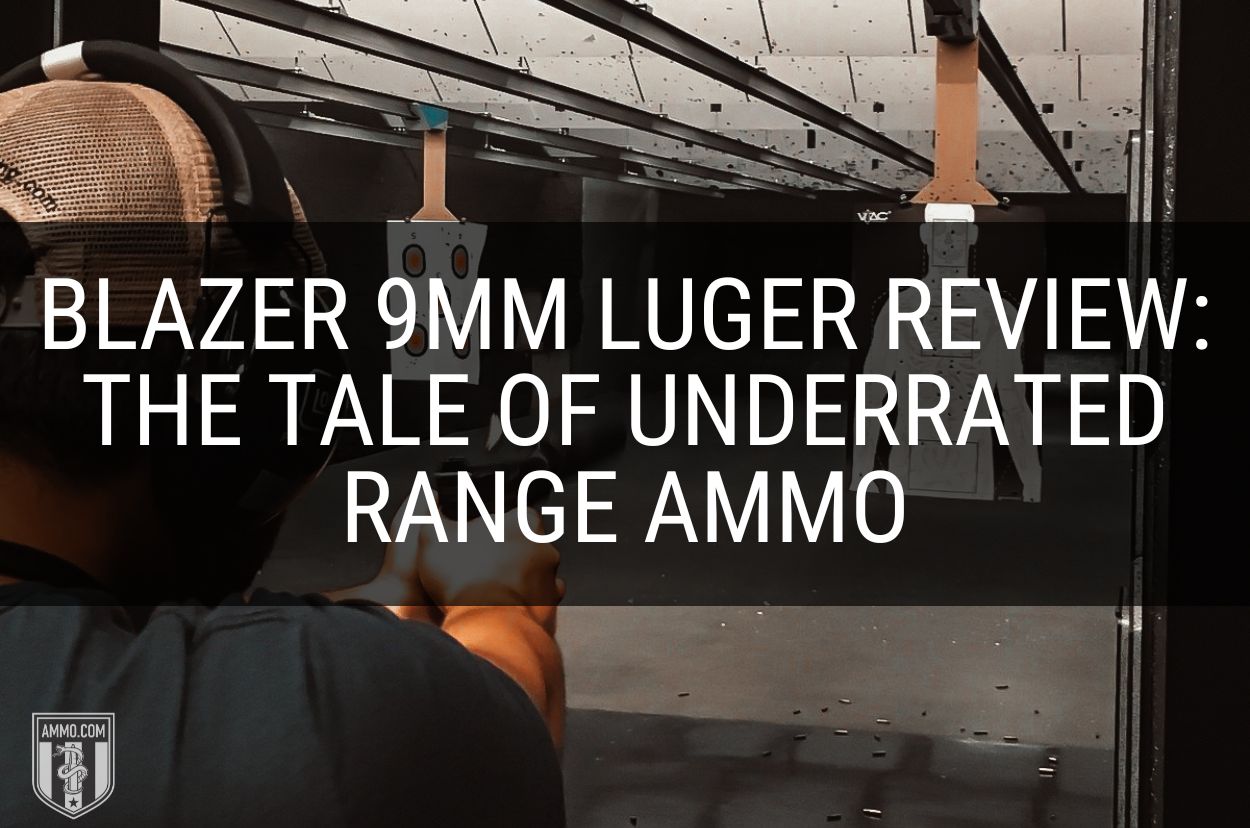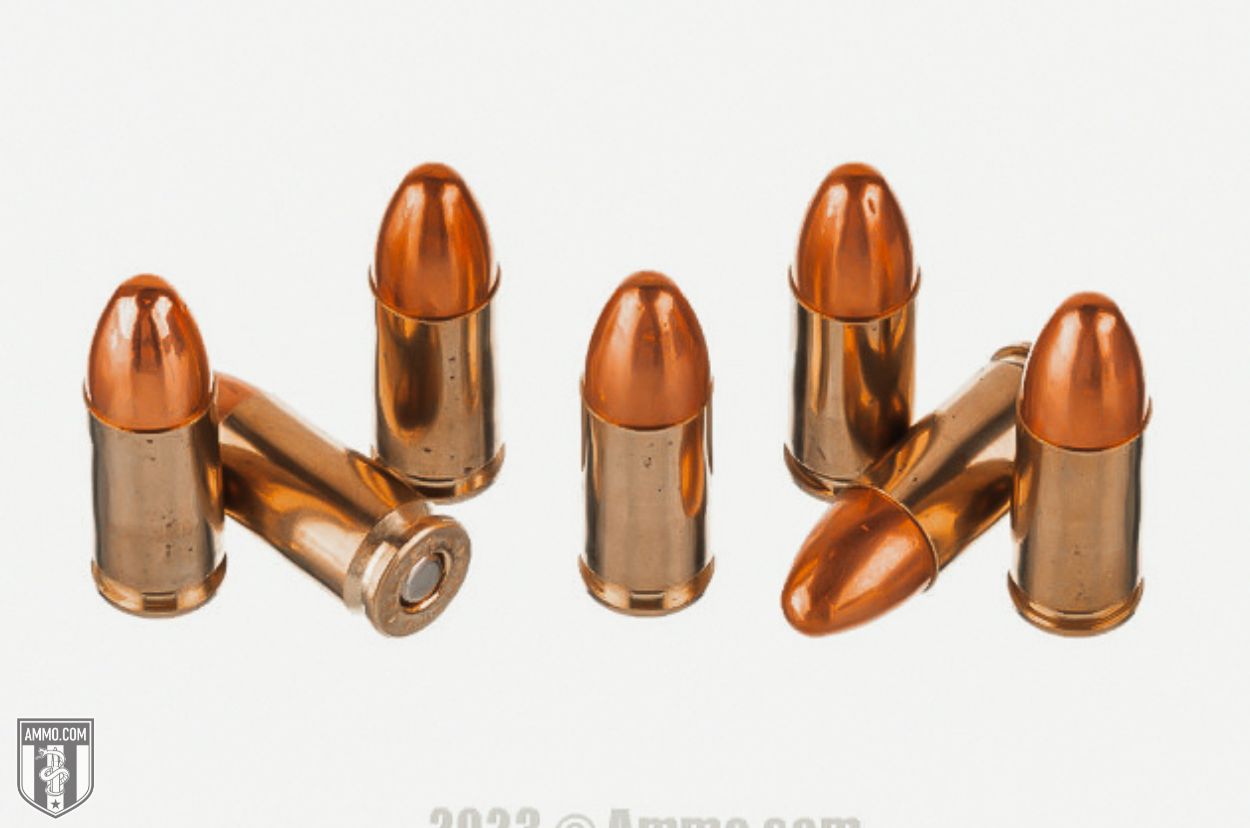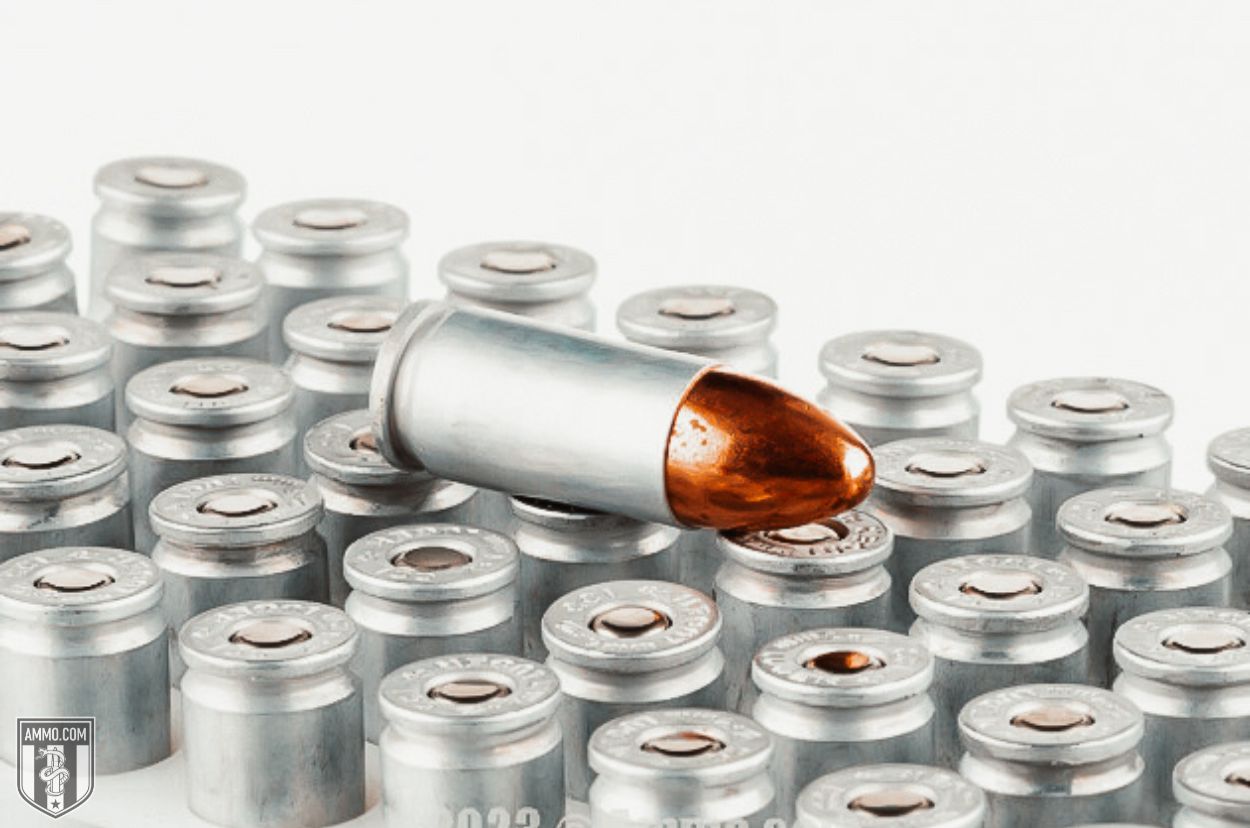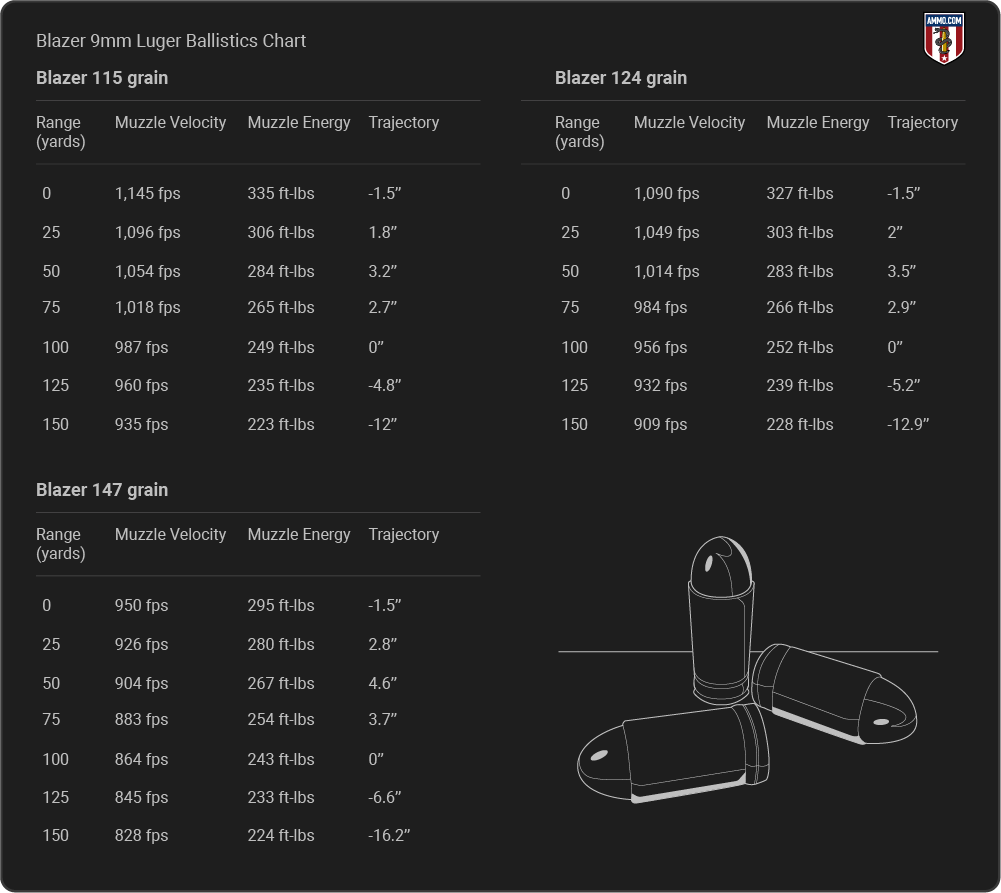Blazer 9mm Luger Review: The Tale of Underrated Range Ammo

Having ammo boxes filled and organized on your shelves is incredibly satisfying. However, aesthetics aren’t the only factor to consider when filling cases. If the ammo you’re stockpiling is full of duds, it’s just a waste of space and money. If you’re looking into the Blazer 9mm Luger 115-grain Full Metal Jacket bullets, we’re here to tell you that it might actually be worth buying.
Naturally, the vast majority of Americans are shopping on a budget these days. When we find cheap ammo available, it’s hard to resist the temptation to jump on it. If I’ve already convinced you to buy it, click HERE. Otherwise, keep reading my comprehensive review of these FMJ bullets.
Blazer 9mm Luger Overview
The 9mm is one of the most common calibers in the US. It’s great for self-defense, target practice, and competition shooting. You can buy 9mm handguns and carbine rifles. The caliber is over 120 years old, developed by Georg Luger using a 7.62.21mm parent case. The 9X19mm is a timeless classic, trusted and widely used for various shooting activities globally.
If you Google “Blazer ammo,” you’re going to get a confusing list of results that lead you down a rabbit hole of confusion regarding who owns and manufactures the ammo. So, let’s clear all of that up first.
CCI actually manufactures blazer ammo. However, many confuse it with Federal ammo because both have the same parent company (Vista Outdoors). Furthermore, the CCI manufacturing plant in Idaho also produces Speer ammo. This, makes sense because CCI and Speer were founded by brothers Dick and Vernon Speer.
CCI (Cascade Cartridges Inc.) hit the ammo scene in the 1950s, but it wasn’t until the early 1980s that the company released the Blazer series. Blazer is a low-cost option for training, plinking, and target practice. The company produces several calibers, but what makes this ammo more interesting is the brass and aluminum options.
More specifically, Blazer manufactures FMJs and TMJs for 9mm handguns (and other calibers like the .45 ACP). Although, some have brass cases, while others have aluminum cases. It’s all non-corrosive centerfire cartridges, which differ a bit.
A chief complaint regarding Blazer aluminum cases is that you’ll have more FTEs (failure to eject), than brass rounds. While this isn’t my experience, it may be worth considering. However, the biggest deciding factor between the two cartridges is whether you want to reload your own ammo or not.
If that doesn’t interest you, the aluminum cases will save you money. If you want a little more bang for your buck, though, go with brass and reload it.
For more options, check out our full selection of Blazer Brass 9mm Ammo.
Our Blazer 9mm Luger Review

I fell in love with CCI ammo shooting the .22LR LRNs. The company has everything that I want at the range. It’s cheap, reliable, and it’s available (that’s a huge selling point). The CCI Blazer 9mm Luger is just as impressive as the round that turned me onto the company.
The Blazer 9mm Luger is great ammo at a great price. It performs well, and the brass casings chamber smoothly. Overall, it’s a good buy, and I’ve never had a problem with it. Whether you’re buying 9mm bulk ammo or you want to spend a long day at the shooting range, it’s a great option.
Now, some shooters may have the occasional issue with a jam or dud, but based on my experience, this is incredibly rare. In fact, Blazer FMJs are comparable to the 9mm Winchester White Box, Federal’s 115-grain FMJs, or Speer Lawman, all in a similar price range.
The 9mm Blazer comes in three grain weights. You can get the 115-grain, 124-grain, or the 147-grain options. So, you can choose between heavy and slow or light and speedy. If you aren’t sure which one you need, I’ve included a breakdown below.
The standard muzzle velocity of a 9mm FMJ is between 1,100 and 1,200 fps. The Blazer 9mm falls right in line with this expectation. However, speeds do vary depending on grain weight and barrel length. For example, the Kel-Tec Sub 2000 carbine reaches muzzle velocities up to 1,266 fps based on tests.
Furthermore, the heavier 147gr Blazer 9mm has a standard muzzle velocity of 950 fps. Ultimately, no matter which way you look at it, the CCI Blazer FMJs are just as good as some of the other popular brands.
What is it Best for?
While hitting your target is probably the most important aspect of any firearm-related activity, the type of rounds you’re using still matters. For example, an FMJ can, technically, take down a deer. But it certainly isn’t ethical or ideal.
Furthermore, the 9mm is an excellent caliber for personal defense, but FMJs aren’t ideal for your EDC ammo, either. The lead core is fully encased in a copper jacket. Its only job is to penetrate whatever it hits. On the contrary, your self-defense ammunition needs to expand after impact to stop threats, so don’t use it for that, either.
Overall, the Blazer 9mm is an excellent choice for target shooting, plinking, and training. It’s a low-cost cartridge that performs well, and it’s typically easy to find in bulk quantities. Check out our bulk 9mm ammo page, for deals that won't break your bank.

Disadvantages
Not every ammo is worth buying. While Blazer 9mm is superb, it does have a few disadvantages. First, and as mentioned previously, it isn’t versatile enough for hunting and EDC. Next, it’s cheap and great for buying in bulk, but I wouldn’t stockpile this for defensive use. Finally, it can be a bit challenging to find the higher-grain FMJs in stock.
However, it is great ammo and meets all of our range ammo needs. It’s high-quality, you’ll rarely experience misfires, and even law enforcement officers use it for qualifications.
Pros and Cons
Pros
- It’s reliable
- The 115-grain is relatively easy to find
- It’s reputable
- It’s cheap
- I’ve experienced no duds or jams
- It’s great for buying in bulk
Cons
- Some grain weights can be challenging to find
- Not for defensive use or hunting
Variations

As promised, I’m going to break down each variant. While I personally wouldn’t pass up any CCI Blazer brass ammo with a small price tag, there are some differences in the variations. I’ve pretty much beat a dead horse with the aluminum versus brass debate, so I’ll cover the different grain weights in this section.
Blazer 9mm 115gr
The most common Blazer ammunition is the 115-grain FMJ, but you can also pick it up as a TMJ. While some may not be aware, FMJs aren’t allowed at all shooting ranges. If you run into that issue, get the TMJs HERE.
The 115-grain 9mm Luger Blazer ammunition is an FMJ with 1,145 fps muzzle velocity and 335 ft-lbs muzzle energy. However, the speeds you’ll see also depend on the firearm you’re using.
For example, the Blazer 9mm 115-grain hits speed around 1,130 fps with a standard Glock 46 3.9” barrel. On the other hand, you can reach muzzle velocities of up to 1,200 fps with a 4” barrel or more.
Blazer 9mm 124gr
The 124gr is a good mid between the other two. It’s a bit heavier and slower than the 115gr, but it also has more energy than the lighter version. The 124gr Blazer 9mm cartridge has a muzzle velocity of 1,090 fps and 327 ft-lbs of muzzle energy.

You’ll keep optimal speeds up to about 50 yards. Furthermore, I’m recommending the 124gr because it mimics one of my favorite self-defense rounds, the Speer Gold Dot +P. If you’re training for defense, the 124gr 9mm Blazer will have similar recoil and performance.
Blazer 9mm 147gr
Finally, the heaviest variation Blazer offers is the 147 grain full metal jacket. This is a bit beefier than the other options. It’s going to travel slower at 950 fps, and the muzzle energy is a bit lower than the 124gr (295 ft-lbs).
Furthermore, you won’t get the same distance as the lighter bullets. The 147gr is better at distances within 25 yards. Another point that I should make is that not all firearms like subsonic rounds. The 147gr is something you should test before buying in bulk. Buy one or two boxes and go have fun at the range, then decide whether you want more.
Blazer 9mm TMJs
Another 9mm Blazer variation I have yet to discuss is the TMJs. Unlike the FMJs listed above, the TMJs have total metal jackets. This is an important distinction for some ranges and those who want to decrease their risk of lead exposure.
Whereas FMJ bullets have the jacket applied to only a section of the lead core, TMJs are fully encased in a copper jacket. So, if you are worried about FMJs, Blazer TMJs are another option.
Ballistics of the Blazer 9mm Luger Bullets
Before you pick up a box of any old Blazer 9mm ammo, it’s a good idea to consider the variations in ballistics. As mentioned above, there are three-grain weights available. Here are the ballistics of the 115, 124, and 147-grain bullet weights.

Parting Shots
If you’re looking for good ammo at a good price without sacrificing quality, I really enjoy Blazer 9mm ammunition. It’s comparable to other popular brands like the Federal American Eagle and Remington Range Ammo.
The reloadable brass cases are my preferred cartridges, but you can use the aluminum ones and save some money. The ammo is made in the USA, highly trusted, and you won’t experience any misfires or malfunctions.
FAQs
We always like to wrap up our ammo reviews with the answers to your most frequently asked questions. Here are the answers to your most pressing questions about Blazer 9mm handgun ammo.
Is Blazer 9mm Luger worth buying?
Yes. It’s cost-effective and reliable. Furthermore, it’s widely available and you have a lot of options to better suit your needs.
What is the range of a Blazer 9mm Luger?
The answer to this question depends on several factors. However, you can expect to get about 60 yards of range with the Blazer 9mm Luger ammo.

Where is Blazer 9mm Luger made?
Blazer ammo is made in the USA at the CCI plant in Lewiston, Idaho. This plant also makes ammo for Speer and Federal.
What’s the average muzzle velocity of the 115-grain full metal jacket?
The average muzzle velocity of a 115-grain 9mm projectile is about 1,100 fps.
Are Blazer 9mm FMJs corrosive?
No. The Blazer 9mm primers are non-corrosive.
Does law enforcement use Blazer 9mm for qualifications?
Yes. Some agencies do. Others use Speer Lawman and a variety of other low-cost 9mm TMJs.
Is the 9mm Blazer 147-grain good for target practice?
Absolutely. It’s heavier and slower, but it is a great option for target practice.
Does Blazer make hollow-point handgun ammo?
Yes, Blazer also manufactures some JHP (jacketed hollow point) ammo. However, there are better self-defense options coming out of the factory in Idaho, like Speer Gold Dot and Federal HST.
Ammunition Reviews
- Federal Punch Ammo Review
- Magtech 5.56 Ammo Review
- Hornady 6mm ARC Ammo Review
- Hornady LeveRevolution 30-30 Ammo Review
- Hornady Superformance 6.5 Creedmoor Ammo Review
- Hornady Critical Duty 9mm Ammo Review
- Federal 22LR AutoMatch Ammo Review
- Golden Tiger 7.62x39 Ammo Review
- Federal Non-Typical Ammo Review
- CCI Blazer Aluminum 9mm Ammo Review
- Hornady SST Ammo Review
- Aguila Minishells Review
- Federal American Eagle Ammo Review
- Hornady American Whitetail Ammo Review
- Rio Shotgun Shells Review
- Hornady Frontier 5.56 Ammo Review
- Aguila .22LR Ammo Review
- Federal Training Ammo Review
- Hornady Critical Defense 9mm Review
- Federal Hydra-Shok 380 Review
- Wolf Military Classic 7.62x39 Review
- Federal Syntech Review
- Hornady Critical Defense Review
- Hornady SST Muzzleloader Bullets Review
- Federal Hydra Shok 12 Gauge Slug Review
- Hornady American Whitetail 223 Review
- Hornady Black Ammo Review
- Federal Power Shok Ammo Review
- 338 Lapua Ammo Review
- Hornady American Gunner 300 Blackout Ammo Review
- Federal MeatEater Ammo Review
- Blazer Brass 380 Ammo Review
- Blazer 9mm Luger Review
- Hornady LeveRevolution 44 Mag Review
- Federal Independence Ammo Review
- PMC X-TAC 5.56 Ammo Review
- Hornady Superformance 30-06 165gr SST Review
- Federal Champion 9mm Ammo Review
- Blazer Brass 9mm Ammo Review
- Magtech 9mm 124gr Ammo Review
- Magtech 308 Win 168gr HPBT Ammo Review
- Sellier and Bellot 9mm 124gr Ammo Review
- Rifle Line Ammo Review
- Wolf Performance 7.62x39 Ammo Review
- Wolf 6.5 Grendel Ammo Review
- Sellier and Bellot 300 Blackout Subsonic Ammo Review
- Magtech 45 ACP Ammo Review
- Brown Bear 223 Ammo Review
- Hornady Full Boar 223 Ammo Review
- Federal Hydra Shok 9mm Review
- 270 Hornady American Whitetail Review
- Hornady American Whitetail 308 165-Grain Review
- Blazer 9mm 115-Grain Review
- Hornady Black 6.5 Grendel Ammo Review
- Hornady 300 Blackout 190 Gr Sub-X Review
